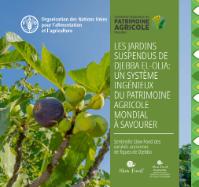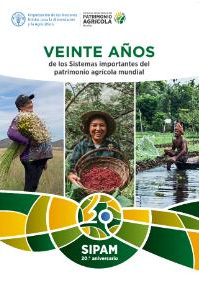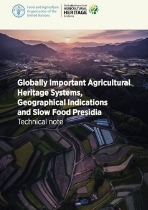As part of the collaboration between the FAO GIAHS Secretariat and the Slow Food Foundation, the ancient varieties of figs in the Hanging Gardens from Djebba El-Olia GIAHS site were included in the Slow Food Presidium catalog with the aim of recognizing the importance and urgency of preserving this agricultural heritage site.
Language: French
La siguiente publicación es una recopilación de historias de éxito de diferentes sistemas importantes del patrimonio agrícola mundial y pretende mostrar los logros de los últimos 20 años desde la creación del programa SIPAM de la Organización de las Naciones Unidas para la Agricultura y la Alimentación. La publicación reúne historias de éxito de la República Unida de Tanzania, China, Japón, Italia, España, Perú y Argelia para ofrecer una visión general de lo que ha cambiado desde que estos sistemas fueron designados como sistemas importantes del patrimonio agrícola mundial.
This report seeks to provide the countries in the Europe and Central Asia region with an overview and real examples of Nature-based Solutions (NbS) applied to agriculture. This is FAO’s first attempt to present NBS applied to agriculture especially pointed at the countries of this region, prompting the scaling-up of these actions as solutions to brought ashore the transition towards resilience and sustainable agriculture.
This technical note highlights the specificities of each approach, clarifies key differences between them and explores possible synergies. It also aims to encourage farmers and governments to contribute to and support the conservation of these fragile and remarkable local food systems, and as such, to the achievement of the Sustainable Development Goals (SDGs). The note focuses on three approaches in particular: Globally Important Agricultural Heritage Systems (GIAHS), Geographical Indications (GI) and Slow Food Presidia.
Han pasado unos 12 000 años desde que los seres humanos abandonaron la práctica de la caza y recolección. Habían concebido la idea de ahorrar y plantar semillas de una campaña a la siguiente, lo que significaba que, en lugar de tener que andar incesantemente en busca de alimentos, podían permanecer en un lugar. Podían así centrarse en la creación de comunidades y, a la vez, en el desarrollo de sistemas agrícolas adaptados al clima del lugar que les permitieran sobrevivir e incluso prosperar en l as tierras donde se asentaban. A medida que una generación mejoraba el legado de la anterior, estos ingeniosos sistemas transmitían, siglo tras siglo, conocimientos autóctonos.
El Programa “Sistemas Importantes del Patrimonio Agrícola Mundial” tiene como objetivo identi car, apoyar y proteger sistemas agrícolas que han creado y donado a nuestro mundo paisajes, biodiversidad, conocimiento y cultura. Estos sistemas representan la esencia de lo que debería ser el desarrollo sostenible. La FAO, en colaboración con otras organizaciones y comunidades locales, trabaja implementando diversas líneas de acción.







